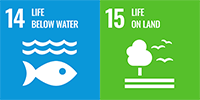We integrate the protection of biodiversity and ecosystem services across the life cycle of all of our operations. Biodiversity preservation is always factored into our operational practices and management system. Protecting biodiversity and ecosystems is critical to sustainable development and supporting our communities.
Aerial view of rainforest canopy near Quince Mil, Peru

Our commitment to conserving the environment is reinforced by our efforts in preserving biodiversity during the construction and operation of Hunt assets.
Put simply, biodiversity is the variety of life on the planet. Natural biological diversity in ecosystems provides direct benefits and products to people, such as medicines, shelter, food, fuel, and clothing as well as cultural, aesthetic and recreational values.
We raise awareness of the importance of conserving biodiversity and ways the Company is addressing it. We avoid development near sensitive species or habitats by considering biodiversity early on in our decision making.
Our approach to biodiversity and ecosystems globally is guided by the same universal principles but tailored to the individual ecosystems we encounter, to achieve no overall negative impact on biodiversity utilizing the mitigation hierarchy of avoid, minimize, restore, and offset.
This approach integrates the conservation needs with the development priorities. Community engagement is critical in the success of our programs, ensuring community concerns and local knowledge is incorporated into any mitigation planning.
We establish partnerships to enhance our biodiversity programs with local universities and institutions such as Smithsonian Institute, Heinz Foundation, and National Geographic.
Biodiversity monitoring and assessment program
The Biodiversity Monitoring and Assessment Program (BMAP) is one of the phases within our Biodiversity Action Plan (BAP). This program was developed over a decade ago as a collaboration between Hunt and the Smithsonian Conservation Biology Institute (SCBI).
The BMAP identifies any impacts, both positive or negative, that HUNT Peru projects or operations might have on an environment’s biodiversity by evaluating the status and trends of selected species and habitats and the effectiveness of the project avoidance, mitigation, restoration and conservation efforts. This scientific approach enables our teams to adapt the environmental programs in place to ensure negative impacts are mitigated and positive impacts are reinforced.
Our BMAP covers coastal and mountain areas, consisting of the following components:
Bio-restoration
Freshwater ecosystems
Marine ecosystems (participatory monitoring)
A conservation program

“The Smithsonian Conservation Biology Institute and Hunt Oil partnership has been instrumental in the understanding of complex ecological systems in Peru to effectively achieve environmental impact mitigation. Moreover, the collaboration has contributed important biodiversity new knowledge by addressing challenging environmental questions and applying science to find solutions for well-informed management decisions.”
Francisco DallmeierSmithsonian Conservation Biology Institute





